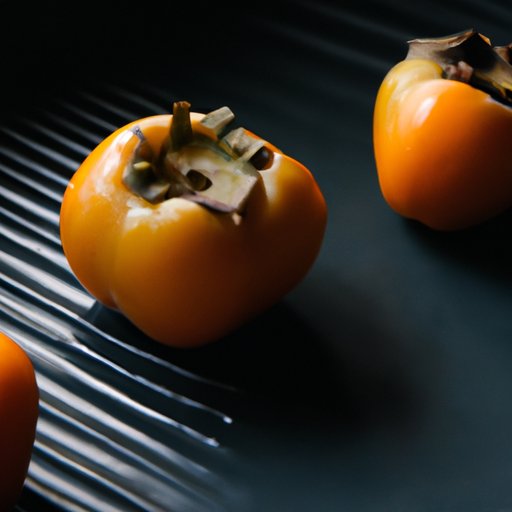Introduction
Persimmons are a unique fruit that can be enjoyed on their own or used in a variety of recipes. From their sweet, honey-like flavor to their smooth texture, persimmons are a great addition to any diet. Whether you’re a seasoned persimmon eater or trying one for the first time, this article will cover everything you need to know about enjoying this delicious fruit.
A Beginner’s Guide to Eating a Persimmon
Persimmons come in two main varieties, astringent and non-astringent. Astringent persimmons are bitter and unpalatable until they are fully ripe, while non-astringent persimmons can be eaten while somewhat firm and have a milder taste. When selecting a persimmon, choose one that is plump, round, and has smooth, unblemished skin. Avoid ones with bruising or soft spots.
To tell when a persimmon is ripe, gently press the stem end. If it yields slightly, the fruit is ripe and ready to eat. If it’s still firm, the persimmon needs more time to ripen. Some people prefer to eat persimmons skin-on, while others prefer to peel the skin off. If you choose to peel the skin, a vegetable peeler works well. Then, cut the persimmon crosswise or lengthwise, and remove any seeds or stems.
If you’re new to eating persimmons and are worried about the astringent taste, there are a few things you can do to avoid it. One is to wait until the persimmon is fully ripe, so it’s as sweet as possible. You can also place it in the freezer for a few hours before eating it, as this will break down the tannins that cause the bitterness.
Recipe Ideas for Incorporating Persimmons into Your Diet
Persimmons are a great addition to any meal or snack and can be used in a variety of different dishes. Here are a few recipe ideas to get you started:
- Slice persimmons and add them to your morning oatmeal or yogurt bowl.
- Make a persimmon smoothie by blending a ripe persimmon with almond milk, banana, and cinnamon.
- Bake persimmons into desserts like bread, muffins, or cakes.
- Add sliced persimmons to salads, or even use them as a topping for pizza.
These are just a few ideas, but persimmons are versatile and can be used in many other recipes as well. Not only do they add sweetness and flavor, but persimmons are also high in fiber, vitamins, and antioxidants.
The Health Benefits of Persimmons
Persimmons are packed with nutrients, making them a great addition to any healthy diet. They are a good source of vitamin A, which is important for immune function and eye health. Persimmons are also high in fiber, which can help regulate digestion and keep you feeling full. Additionally, persimmons are chock-full of antioxidants, which can help improve heart health and provide various other health benefits.
According to a study published in the Journal of Food and Science, persimmons have been found to lower cholesterol and lower blood pressure. Another study found that persimmons can boost the immune system and help prevent certain diseases.
Persimmons Around the World
Persimmons are enjoyed in many parts of the world and play a significant role in various cuisines and cultures. In Japan, persimmons are often eaten dried and are a popular snack during the winter months. In Korea, persimmons are often eaten fresh and used in traditional dishes like kimchi. In China, persimmons are used in spicy soups and stews, while in Spain, they are used in desserts like tarts and cakes.
In some cultures, persimmon leaves are used for medicinal purposes. Native Americans have used persimmon leaves for their anti-inflammatory properties, and in China, persimmon leaf tea is used to prevent colds and reduce high blood pressure.
How to Store and Preserve Persimmons
Once you have purchased persimmons, you can store them at room temperature until they are fully ripe. Once ripe, you can store them in the refrigerator for up to a week. If you have too many ripe persimmons, you can also freeze them for later use. Simply slice the fruit and store it in a freezer-safe container. Frozen persimmons can be used in smoothies or other recipes.
It’s essential to note that persimmons are not suitable for everyone, as some people may have an allergy or sensitivity. If you experience any symptoms like hives or difficulty breathing after eating persimmons, seek medical attention immediately.
Conclusion
With their sweet, honey-like taste and smooth texture, persimmons are a delicious and nutritious fruit to add to any diet. Whether you’re a fan of eating them fresh or love incorporating them into your recipes, persimmons are versatile and offer many health benefits. Give them a try, and you may find yourself with a new favorite fruit.
